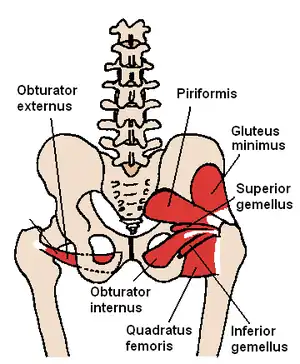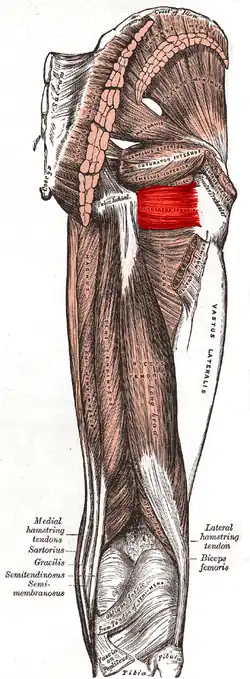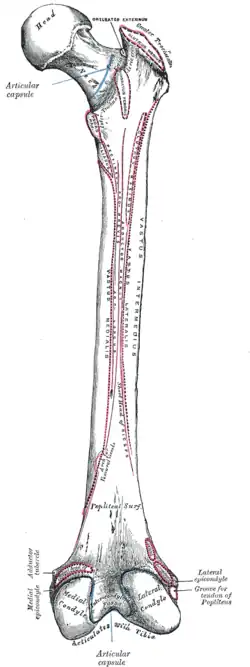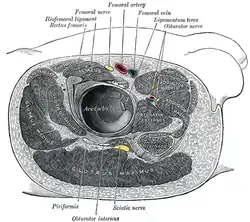Quadratus femoris muscle
| Quadratus femoris muscle | |
|---|---|
 The quadratus femoris and nearby muscles | |
 Muscles of the gluteal and posterior femoral regions with quadratus femoris muscle highlighted | |
| Details | |
| Origin | Ischial tuberosity |
| Insertion | Intertrochanteric crest |
| Artery | medial circumflex femoral artery |
| Nerve | Nerve to quadratus femoris (L4-S1) |
| Actions | lateral rotation and adduction of thigh[1] |
| Identifiers | |
| Latin | musculus quadratus femoris |
| TA98 | A04.7.02.015 |
| TA2 | 2608 |
| FMA | 22321 |
| Anatomical terms of muscle | |
The quadratus femoris is a flat, quadrilateral skeletal muscle. Located on the posterior side of the hip joint, it is a strong external rotator and adductor of the thigh,[2] but also acts to stabilize the femoral head in the acetabulum. Quadratus femoris use in the Meyer's muscle pedicle grafting to prevent avascular necrosis of femur head.
Course
It originates on the lateral border of the ischial tuberosity of the ischium of the pelvis.[1] From there, it passes laterally to its insertion on the posterior side of the head of the femur: the quadrate tubercle on the intertrochanteric crest and along the quadrate line, the vertical line which runs downward to bisect the lesser trochanter on the medial side of the femur. Along its course, quadratus is aligned edge to edge with the inferior gemellus above and the adductor magnus below, so that its upper and lower borders run horizontal and parallel.[3]
At its origin, the upper margin of the adductor magnus is separated from it by the terminal branches of the medial femoral circumflex vessels.
A bursa is often found between the front of this muscle and the lesser trochanter. Sometimes absent.
Clinical significance
Groin pain can be a disabling ailment with many potential root causes: one such cause, often overlooked, is quadratus femoris tendinitis. Magnetic resonance imaging can show abnormal signal intensity at the insertion of the right quadratus femoris tendon, which suggests inflammation of the area.[4] Since the muscle works to laterally rotate and adduct the femur, actions involving the lower body can strain the muscle. In addition, patients present with hip pain and an increased signal intensity of the MRI of the quadratus femoris have been shown to also have a significantly narrower ischiofemoral space compared to the general populace. The ischiofemoral impingement may be a cause of the hip pain associated with quadratus femoris tendinitis.[5]

Additional images
 Right femur. Posterior surface.
Right femur. Posterior surface. Structures surrounding right hip-joint.
Structures surrounding right hip-joint. Nerves of the right lower extremity Posterior view.
Nerves of the right lower extremity Posterior view. Quadratus femoris muscle
Quadratus femoris muscle Muscles of Thigh. Anterior views.
Muscles of Thigh. Anterior views.
Notes
- 1 2 Thieme Atlas of Anatomy (2006), p 424
- ↑ Platzer, Werner (2003). Color atlas and textbook of human anatomy (5th rev. and enlarged [English] ed.). Stuttgart: Thieme. p. 238. ISBN 978-1-58890-159-0. OCLC 54767617.
- ↑ Abrahams, Peter H.; Marks, S. C.; Hutchings, R. T. (2003). McMinn's color atlas of human anatomy (5th ed.). Edinburgh: Mosby. p. 166. ISBN 0-7234-3212-0. OCLC 50477357.
- ↑ Klinkert, P. (1997). "Quadratus femoris tendinitis as a cause of groin pain". British Journal of Sports Medicine. 31 (4): 348–349. doi:10.1136/bjsm.31.4.348. PMC 1332577. PMID 9429017 – via BMJ.
- ↑ Torriani, Martin; Souto, Silvio C. L.; Thomas, Bijoy J.; Ouellette, Hugue; Bredella, Miriam A. (2009-07-01). "Ischiofemoral Impingement Syndrome: An Entity With Hip Pain and Abnormalities of the Quadratus Femoris Muscle". American Journal of Roentgenology. 193 (1): 186–190. doi:10.2214/AJR.08.2090. ISSN 0361-803X. PMID 19542413.
References
![]() This article incorporates text in the public domain from page 477 of the 20th edition of Gray's Anatomy (1918)
This article incorporates text in the public domain from page 477 of the 20th edition of Gray's Anatomy (1918)
- Mcminn, R.M.H. (2003). Last's Anatomy Regional and Applied. Elsevier Australia. ISBN 0-7295-3752-8.
- Platzer, Werner (2004). Color Atlas of Human Anatomy, Vol 1: Locomotor system (5th ed.). Thieme. ISBN 3-13-533305-1. (ISBN for the Americas 1-58890-159-9.)
- Thieme Atlas of Anatomy. Thieme. 2006. ISBN 978-1-60406-062-1.
External links
- PTCentral
- Anatomy photo:13:st-0409 at the SUNY Downstate Medical Center